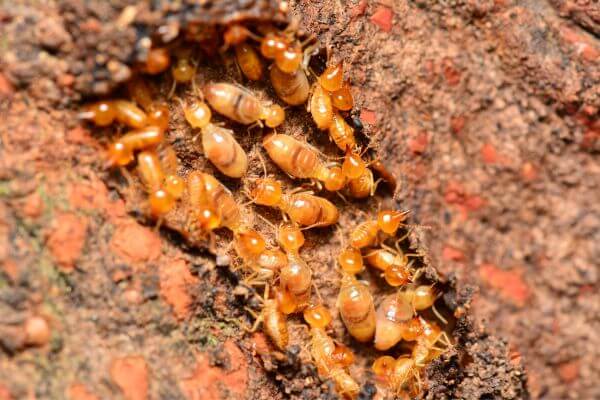The coexistence between humans and termites is not always harmonious. These small social insects, known for their capacity for destruction, are often seen as a threat when they invade our properties. The battle for ownership and damage prevention between termites and humans is a constant struggle that involves preventive measures, control techniques and the search for sustainable solutions. In this article, we will explore the dynamics of this battle, from the behavior of these insects to the strategies employed by humans to protect their properties.

Termite behavior and social structure
To understand the battle against termites, it is important to know their behavior and social structure. These insects live in highly organized colonies made up of different castes such as workers, soldiers, breeders, and the queen. Workers are responsible for building and maintaining the termite mound, while soldiers protect the colony against threats. The reproductives, which include the queen and the winged males, are responsible for the reproduction and expansion of the colony.
Human Property at Risk
Termites are known for their ability to cause damage to wooden structures such as furniture, floors and even building structures. These insects feed on cellulose, an essential component of wood, and can cause serious damage to human property if not properly controlled. In addition, the presence of termites in a property can also affect its market value and cause homeowners concern and discomfort.
Termite Prevention and Control Techniques
There are several techniques employed by humans to prevent and control termite infestations. A key preventative measure is to ensure that the property is securely fenced, with all cracks and crevices sealed, to prevent these insects from entering. In addition, eliminating sources of moisture such as leaks and wet areas is also important, as termites are attracted to water.
Another common strategy is the application of chemical treatments, such as insecticides, which aim to eliminate or repel termites. These products can be applied in strategic spots, such as around wooden structures or around the perimeter of the property. However, it is essential that these products are used with caution, following safety recommendations and considering their environmental impact.
Sustainable Termite Control Alternatives
With the growing interest in more sustainable solutions, alternatives to the use of chemical products for termite control have emerged. One of these options is the use of baits, which consist of attractive substances mixed with a toxic agent that is taken back to the colony by the worker termites.
This approach aims to target the entire colony, including the queen, and may be a safer and more effective alternative compared to conventional insecticides. Another sustainable alternative is the use of physical methods, such as controlled heating or cooling of infested areas. These processes can eliminate termites without the need for chemicals.
Termites in Nature and their Ecological Role
Despite the damage they can do to human property, it is important to remember that termites play a significant role in nature. They are efficient decomposers and help to recycle organic matter, contributing to soil fertility. In addition, termites are also an important food source for other organisms such as birds, mammals and predatory insects.
Challenges and Innovations in Termite Damage Prevention
Despite efforts to prevent and control termites, significant challenges remain. For example, some species have developed resistance to certain insecticides, making control more difficult. In addition, early detection of infestations is also a challenge, as these insects can remain hidden and silent for long periods.
However, scientific research and technological innovation are paving the way for more effective solutions in preventing termite damage. New detection techniques, such as the use of thermographic cameras and humidity sensors, are helping to identify termite infestations more accurately and earlier. In addition, the search for safer and more environmentally friendly products continues to drive the development of new insecticides and control methods.
The battle between termites and humans for ownership and damage prevention is a constant struggle. Although termites can be a threat to structures and human well-being, it is possible to adopt effective preventive approaches and control strategies to minimize the damage caused by these insects.
Implementing preventative measures, such as properly sealing properties and eliminating sources of moisture, is critical to preventing termite infestations. In addition, the use of control techniques such as baiting and physical methods offer more sustainable alternatives to chemical insecticides.
It is also important to recognize the ecological role of termites in nature, remembering that they play important roles in recycling organic matter. Therefore, it is critical to adopt responsible approaches that strike a balance between protecting human properties and preserving termites in the ecosystem.
Although there are challenges to be overcome, such as resistance to insecticides and early detection of infestations, scientific research and technological innovation continue to advance in the search for more effective solutions. Collaboration between homeowners, pest control specialists, researchers and communities is essential for developing integrated termite control strategies.
Awareness plays a key role in this battle. It is important to educate homeowners about preventative measures, such as regularly maintaining their property and conducting periodic inspections to identify signs of infestation. Additionally, disclosing information about termites and their characteristics can help reduce panic and promote a more informed and balanced approach to harm prevention.
Ultimately, the battle against termites requires an integrated and sustainable approach. We must seek solutions that protect our properties without compromising biodiversity and the health of the environment. Cooperation between different stakeholders, together with continuous research and the development of innovative technologies, will lead us to advance this fight and find a balance between preserving termites and protecting our properties.
While the battle between termites and humans continues, we can face it with resilience, knowledge and responsible approaches. Through the implementation of preventive measures, the search for sustainable solutions and the recognition of the ecological role of termites, we can create an environment where the coexistence between humans and termites is possible. Together, we can protect our properties, preserve biodiversity and ensure a sustainable future for all.

